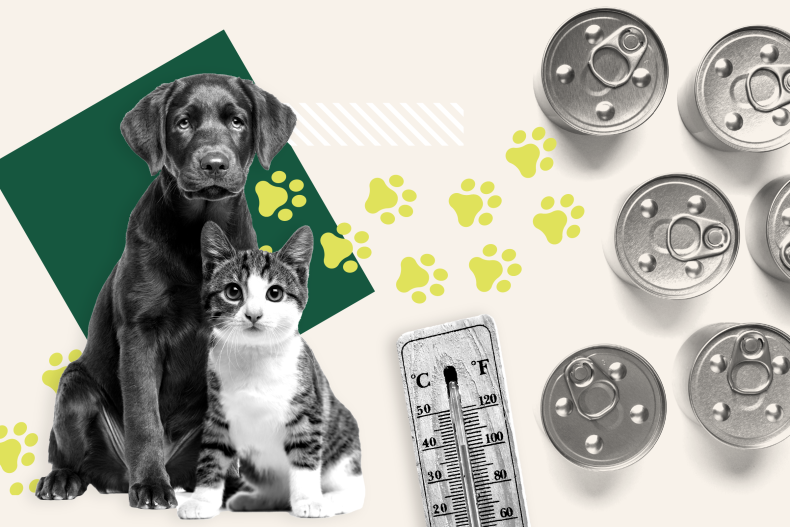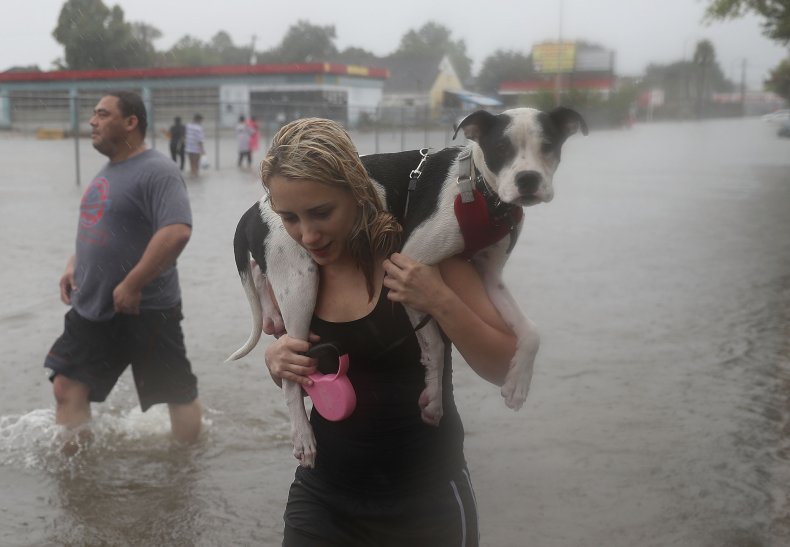As if the loss of human life and billions of dollars in property damage weren't bad enough, add another casualty to this summer's devastating wildfires in Hawaii: an estimated 3,000 pets are lost or missing as a result of the blaze, the Humane Society of Maui says. It's a stark reminder that the rising risks of extreme weather and natural disasters fueled at least partly by climate change aren't limited to animals of the two-legged variety.
"We can't think of these natural disasters as simply a human problem," says Dr. Rena Carlson, president of the American Veterinary Medical Association. "Our pets can be impacted as well."

According to the International Fund for Animal Welfare, the fivefold increase in climate- and weather-related natural disasters that the world faces today versus 50 years ago exposes pets and wildlife to many of the same dangers that people are encountering. Chief among them: excessive heat, along with the introduction of new diseases and the need to flee home without warning due to flash flooding, heavy storms and other sudden weather-related threats.
Fortunately, though, a few key steps can help keep your four-legged family members safe from environmental harm. Here's what you need to do.
Keep Furry Friends Cool
The record high temperatures and heat waves experienced across the U.S. and the world lately can lead to dehydration, heat exhaustion and heat stroke in pets, just as they can in their owners. "There is no set temperature where heat becomes dangerous to pets," says Carlson. "That level can vary based on a pet's physical characteristics, age, weight, underlying medical conditions and activity level."
In greatest danger of heat-related ailments, Carlson says: pets that are older, obese or have pre-existing medical conditions. Animals that have longer or darker fur or belong to brachycephalic breeds—for instance, dogs with flat or pushed-in faces like French bulldogs, pugs and boxers, as well as Persian cats—are also at greater-than-average risk as hotter weather becomes more common.
Higher temperatures can additionally interfere with animals' ability to get the exercise they need to stay healthy, says Clive Wynne, a professor of psychology specializing in animal behavior at Arizona State University and director of its Canine Science Collaboratory. He notes, "As it is, obesity is the biggest health challenge facing our pet dogs and their opportunities for exercise are going to be more curtailed as the climate warms."
In the American South and the Southwest, temperatures are already affecting dogs' ability to be active, says Wynne, an Arizona resident who now walks his 40-pound short-haired, mixed-breed pup before 6 a.m., when temperatures are cooler, to ensure they both get their exercise. In warm areas of the country and during heat waves, Carlson also advises pet owners to limit time outside and to avoid walks with their animals during the middle of the day.
"Instead, enjoy the fresh air together at night or in the early morning and evening when the sun and heat are less severe," she says. "If [you are] outside in the heat, your pets should always have access to fresh water and shade."

Be mindful as well of how hot surfaces like pavement and turf can get, potentially burning and blistering animals' paws, experts warn. To avoid this, make sure your pet has access to shade and grassy areas when outside. And in hot climates and during heat waves, look out for signs of heat stress. Telltale signs include anxiousness or restlessness, excessive panting and drooling, vomiting and diarrhea, abnormal gum and tongue color, unsteadiness or, in a worst-case scenario, collapse.
If your pet does become overheated, take a slow approach to cooling them down, experts recommend, since going too fast can cause an animal's blood vessels to constrict and actually make it more difficult to get relief from the heat. To combat this, Carlson advises applying cool, not cold, water to pets' bodies and paws, then fanning them to help encourage evaporation.
Future pet owners, also take note: If you're planning to adopt an animal, Wynne suggests you choose one that fits the climate in the place you live as well as your lifestyle. "To survive in a warm climate, a dog needs to be smaller, shorter-haired and more lithe of limb," he says. "Save the malamutes, huskies and their ilk for Minnesota and Canada."
Shield Against Growing Disease Risks
Recent changes in climate also increase the risk of infectious diseases for pets, as pathogens become more pervasive in a growing number of areas. According to a study by the International Journal of Environmental Research and Public Health, zoonotic diseases—infections spread between people and animals—have increased in recent years as climate change has made it easier for viruses to spread. Diseases caused by ticks, for example, are growing more prevalent.
Another carrier expected to become more common is the mosquito. Matt Collis, deputy vice president of policy at the International Fund for Animal Welfare (IFAW) says that when the weather grows warmer, "Mosquitos start to occupy more places and they can pass on diseases between populations of animals in ways that wouldn't have happened in the past." Mosquitos can carry heartworms, putting dogs, and sometimes cats and people at risk.
Wild animals moving into new territories to escape environmental damage to their home turf is also changing the disease landscape for companion animals. Emerging evidence shows changing habitat patterns and animals encountering each other in new ways is likely to increase cross-species viral transmission. A rising number of floods also increases the possibility of transmitting waterborne diseases.
To combat potential infection, the IFAW advises keeping your pets up to date on their vaccinations and medications. Also make sure your dog gets a Lyme disease vaccine and keep up to date on parasite prevention to prevent transmission of the disease Babesiosis, caused by microscopic parasites carried by ticks.
Cat owners, in particular, should take precautions by keeping their pet indoors. "Free ranging cats are one of the biggest threats to small wildlife in developed countries and can transmit diseases to humans," says Simon Addison, climate change adviser at the IFAW. Pet cats that live outdoors even part of the time run the risk of contracting and spreading zoonotic diseases like tularemia and plague, as well as being the largest source of human rabies exposure.

Prep a Pet To-Go Bag
Just as is happening in Maui now, rescue facilities typically report an uptick in abandoned and injured pets when environmental catastrophes hit, as owners, caught offguard, rush to save their human family members and property but run out of time to care for their pets. Having an emergency action plan in place for your pet as well as the humans in your household helps ensure all members of your family stay safe in case of a natural disaster. "This includes having plans in place to evacuate with pets, making sure they have food, shelter and medicine required if they have to leave in a hurry," Collis says.
Among the steps to take in advance: microchipping your pets, desensitizing them to their carrier with treats and preparing a to-go bag with pet essentials. "You don't want to do this in a rush at the last minute," Collis says, "so assemble your kit well in advance of any emergency and store it in an easy-to-carry, waterproof container close to an exit."

Your pet disaster kit should include a three- to seven-day supply of dry and canned (pop-top) food, a two-week supply of medicine, a week's worth of water, portable bowls, liquid dish soap, a first aid kit, your pet's identification documents, medical records, emergency contact list and a photo of you and your animal. Also make sure you have a carrier and extra collar that are labeled with your contact information, a flashlight with extra batteries and a muzzle. It can help to bring a comfort item, too, like a favorite toy or familiar blanket.
Your evacuation prep should also include ensuring your pet is welcome where you're headed, Carlson says. She notes that many, but not all, evacuation centers have shelters for pets, so confirm in advance, if possible. If you plan on staying with friends or family, make sure they're aware you'll be bringing pets, too.
Lower Your Carbon Paw Print
While you're protecting your pet from the risks of climate change, also think about how you can protect the climate from your pet since companion animals, like humans, have their own environmental costs. According to the Animal Humane Society, adopting your next pet from a local shelter and sterilizing the animal are two critical ways to be of service to the environment. Switching pets from a meat-based to a plant- or insect-based diet also has significant impact, as meat-heavy food production contributes to high greenhouse gas emissions.
Going greener with pet grooming and cleaning products can also help. Use bio-degradable poop bags and kitty litter, for example, as well as white vinegar and baking soda to mop up pet messes instead of ammonia-based cleaners, and vegetable-based soaps and shampoos versus chemical ones. And favor pet beds, bowls and toys made of sustainable materials instead of plastic, whenever possible.
Despite the growing challenges of pet ownership as the climate changes, Carlson notes that the bond between owners and their animal companions can help mitigate eco-anxiety for both. "Dogs can be highly attuned to human emotions, picking up on things such as our tone of voice, facial expressions and movements," she says. "[Pets'] companionship provides social and emotional support simply by being present in our lives."





